Sikalidis C. (ed.) Advances in Ceramics - Synthesis and Characterization, Processing and Specific Applications
Подождите немного. Документ загружается.

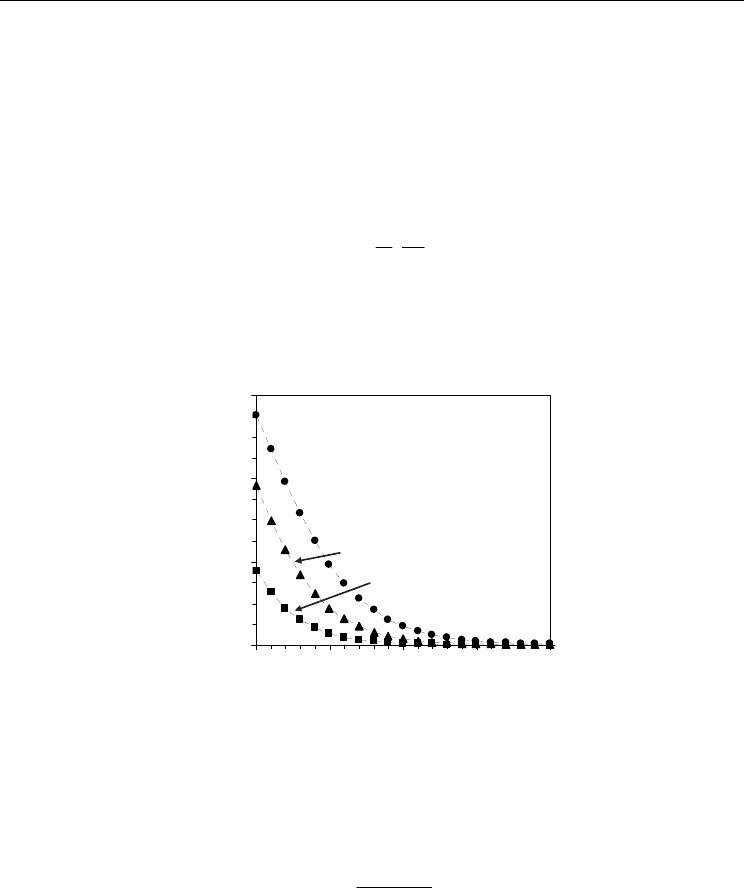
Reducibility of Ceria-Based Materials Exposed to Fuels and under Fuel/Air Gradients
349
lanthanides (Lübke & Wiemhofer, 1999; Steele, 2000; Xiong et al., 2004). According to Eq. 20
and using the results of enthalpy of reduction obtained in section 2.2 we have estimated
values of activation energy for polaron mobility in the range 0.2-0.6 eV (Pérez-Coll et al.,
2007).
The impact of reducibility of ceria-based solid electrolytes is determined mainly by the
average transport number under high gradients of oxygen partial pressure, or
corresponding dependence of average electronic conductivity on Nernst potential (Eq. 14)
under steady-state conditions according to (Pérez-Coll et al., 2007):
e
e,av
0
I
L
=
AV
σ (25)
Equation 25 directly relates the electronic conductivity with the voltage difference between
both sides of the pellet. For this reason it describes the average electronic conductivity of the
sample submitted to a difference of oxygen partial pressure (i.e. pO
2
*
/ceria-sample/pO
2
).
0
0.2
0.4
0.6
-25 -20 -15 -10 -5
log(pO
2
/ atm)
t
e,av
Ce
0.8
Sm
0.2
O
1.9
−Δδ
900ºC
800ºC
700ºC
Fig. 13. Electronic transport number averaged across the mixed conducting membrane
submitted to ion-blocking conditions as function of the oxygen partial pressure for
Ce
0.8
Sm
0.2
O
1.9
−Δδ
at 700, 800 and 900 ºC
The electronic transport number could be averaged across the sample as follows:
e,av
e,av
ie,av
t=
σ
σ+σ
(26)
where σ
i
corresponds to ionic conductivity averaged across the membrane, which is usually
assumed to be constant. Figure 13 shows an example of the effect of oxygen partial pressure
and temperature on the averaged electronic transport number of Ce
0.8
Sm
0.2
O
1.9
−Δδ
estimated
from ion-blocking and impedance spectroscopy results. The electronic character is revealed
by substantial increase in the electronic transport number for very reducing conditions.
However, due to the higher activation energy values for electronic conduction in the order

Advances in Ceramics - Synthesis and Characterization, Processing and Specific Applications
350
of 2.2-2.4 eV compared to those of ionic conduction in the order of 0.5-0.7 eV (Pérez-Coll et
al., 2006) the averaged electronic transference number is decreased when temperature is
lowered.
4. Fuel operating conditions
Previous sections emphasized that reduction of tetravalent cerium and thus the electronic
conductivity in ceria based materials is highly influenced by the oxygen partial pressure.
Under realistic situation in a SOFC the electrochemical reactions at the fuel electrode
generate reaction products in the anode and corresponding changes in gas composition vs
oxygen chemical potential (Frade et al. 2004). Thus interaction of the atmosphere with the
anode materials and also with the contacting electrolyte surface will modify their electrical
and electrochemical properties. In fact, one could expect different levels of fuel conversion
along the anode surface that would be reflected in changes in the mixed transport properties
of ceria-based materials, affecting the local performance of the SOFC due to non-uniform
distribution of current density and corresponding heat management issues.
4.1 Dependence on conversion of hydrogen
The use of hydrogen as fuel in a SOFC produces water at the anode (for an oxide-ion
conductor electrolyte) due to the reaction with the oxygen ions transported through the
electrolyte and electronic transport in the external circuit (Fig. 14). Working conditions
imposed by fuel conversion can be assessed by assuming nearly equilibrium for the overall
reaction:
22 2
2H O H O+⇔ (27)
and corresponding mass action constant:
()
()
2
2
2
22
pH O
K
pO pH
= (28)
where pH
2
O, pO
2
and pH
2
are partial pressures of water, oxygen and hydrogen,
respectively. Moreover, the relation between the equilibrium constant and the Gibbs free
energy (ΔG) is expressed as:
G
Kexp
RT
Δ
=−
(29)
Recombination of Eqs. 28-29 allows one to express the oxygen partial pressure as a function
of steam to hydrogen ratio as follows:
2
2
2
2
pH O G
pO exp
pH RT
Δ
=
(30)
Equation 30 shows that local variations in steam to hydrogen ratio have considerable effects
on the oxygen partial pressure.

Reducibility of Ceria-Based Materials Exposed to Fuels and under Fuel/Air Gradients
351
∇pO
2
O
2−
e
−
O
2−
H
O
H
O
O
H H H H
H
O
H
H H
H H
H H
O
2−
O
2−
H
O
H
H
O
H
O
2−
O
2−
H
O
H
H H
Fuel source
Anode
Cathode
O
O
O
O
O
O
O
O
O
O
H HH
O
H
e
−
H
O
H
O
2−
O
2−
O
2−
O
2−
Fuel Cell
Electrolyte
∇pO
2
O
2−
O
2−
e
−
O
2−
O
2−
H
O
H
HH
OO
HH
O
O
OO
OO
H HHH HH H HHH HH
H
O
H
HH
OO
HH
H HHH HH
H HHH HH
H HHH HH
O
2−
O
2−
O
2−
O
2−
H
O
H
HH
OO
HH
H
O
H
HH
OO
HH
O
2−
O
2−
O
2−
O
2−
H
O
H
HH
OO
HH
H HHH HH
Fuel source
Anode
Cathode
O
O
OO
OO
O
O
OO
OO
O
O
OO
OO
O
O
OO
OO
O
O
OO
OO
H HHH HHH
O
H
HH
OO
HH
e
−
H
O
H
HH
OO
HH
O
2−
O
2−
O
2−
O
2−
O
2−
O
2−
O
2−
O
2−
Fuel Cell
Electrolyte
Fig. 14. Representation of a possible situation in a SOFC with different levels of conversion
and different gas composition at the anode.
-0.1
0.3
0.7
1.1
020406080100
H
2
conversion (%)
log(
σ
e
/ S·m
-1
)
T= 800ºC
x= 0.1
x= 0.3
x= 0.2
Ce
1-x
Sm
x
O
2
−
0.5x
−Δδ
30% 55% 65%
Fig. 15. Electronic conductivity in the reduced side of the samples as a function of the
hydrogen conversion along the surface of the fuel side in the cell for a Sm-doped ceria
system at 800 ºC.
Dependence of oxygen partial pressure on hydrogen conversion should, thus, be reflected in
considerable changes in the electronic properties of ceria-based materials as illustrated in
Fig. 15 for ceria-samaria electrolytes. The increase in the hydrogen conversion has the effect
of lowering the electronic conductivity of the ceria-based materials as the atmosphere
becomes less reducing. In extreme situations the electronic conductivity could be decreased
by 5 to 6 times when the hydrogen conversion is increased from 10% to 90%. On the other
hand, in spite of differences in electronic behaviour for samples doped with different
contents of aliovalent cations, changes in hydrogen conversion may suppress the
differences. The onset of electronic conductivity has also effects on the open cell voltage of
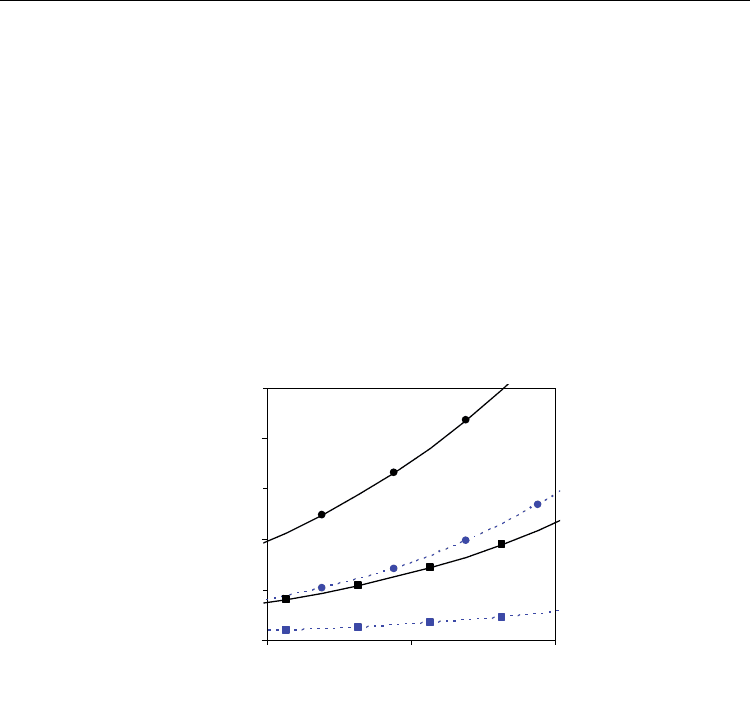
Advances in Ceramics - Synthesis and Characterization, Processing and Specific Applications
352
the mixed conducting membrane (OCV
mc
), which can be estimated in a first approximation
as:
()
mc 0 e, av
OCV OCV 1 - t≈ (31)
where OCV
0
is the ideal open cell voltage for a pure ionic conductor (Eq. 14). Averaged
electronic transport numbers of the mixed conducting membranes estimated from Eq. 26
could be recombinated with Eq. 30 to be represented as a function of the hydrogen:steam
ratio (Fig. 16). It is observed that the increase in the H
2
:H
2
O ratio increases considerably the
electronic transference number, due to more severe reducing conditions, mainly at higher
temperature and for lower values of Sm-content. Values of averaged transport number were
also used to estimate the open cell voltage as function of hydrogen:steam ratio according to
Eq. 31 and some results obtained at 700 ºC are represented in Fig. 17.
0
0.1
0.2
-1 0 1
log(pH
2
/pH
2
O)
t
e,av
x= 0.1
900ºC
900ºC
700ºC
x= 0.3
700ºC
Fig. 16. Averaged electronic transport number at 700 and 900 ºC as a function of
hydrogen:steam ratio in the mixture H
2
+H
2
O, for different Sm-contents in the system Ce
1-
x
Sm
x
O
2-0.5x
−Δδ
. [Continuous line: x= 0.1; dashed line: x=0.3)]
Figure 17 evidences that different mixtures of H
2
+H
2
O produce important changes in the
open cell voltage of the system. In spite of the relatively low temperature of 700 ºC, we can
see substantial differences between the ideal open cell voltage and the current open cell
voltage of the mixed conducting membrane. These differences are more important for
higher values of H
2
:H
2
O ratio and also for lower contents of trivalent dopant, according to
the higher values of averaged electronic transport numbers (Fig. 16). Nevertheless, onset of
mixed conductivity has recognized impact on electrocatalytic processes, which justifies its
use in cermet anodes (Marina et al, 1999). Oxygen stoichiometry changes, and
corresponding oxygen storage ability, may even contribute to minimize carbon deposition
in those ceria-based anodes.
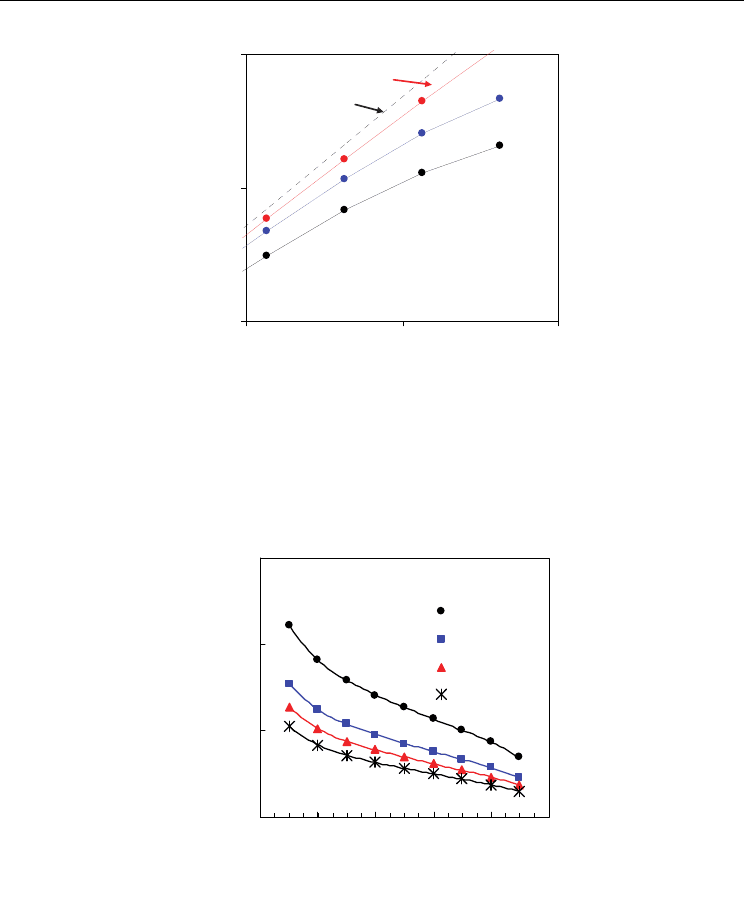
Reducibility of Ceria-Based Materials Exposed to Fuels and under Fuel/Air Gradients
353
0.8
0.9
1
-1 0 1
log(pH
2
/pH
2
O)
OCV (V)
x=0.1
x=0.2
x=0.3
700 ºC
Ce
1-x
Sm
x
O
2
−
0.5x
−Δδ
Pure-ionic
conductor
Fig. 17. Predictions of open cell voltage vs hydrogen:steam ratio for several contents of Sm
in Ce
1-x
Sm
x
O
2-0.5x-
Δδ
at 700 ºC, based on the experimental dependence of electronic transport
properties.
0
0.1
0.2
0.3
0 20406080100
H
2
conversion (%)
t
e, av
0 mV
50 mV
75 mV
100 mV
Ce
0.9
Sm
0.1
O
1.95
−Δδ
800ºC
η
a
= 0 mV
η
a
= 50 mV
η
a
= 75 mV
η
a
= 100 mV
Fig. 18. Electronic transport number averaged across the membrane as function of hydrogen
conversion for several values of anodic overpotential.
SOFC operation also yields overpotential contribution η
a
at the anode, and corresponding
changes in actual reducing conditions imposed on materials exposed to fuels, i.e. (D. Pérez-
Coll et al., 2010):

Advances in Ceramics - Synthesis and Characterization, Processing and Specific Applications
354
2
a
2-R
RT pO
η =ln
4F pO
(32)
where the real oxygen partial pressure imposed on materials (pO
2-R
) differs from the
equilibrium oxygen partial pressure in the atmosphere (Eq. 30). Figure 18 shows the values
of averaged electronic transport number as function of hydrogen conversion for different
values of anodic overpotentials. It is highlighted that the increase in anodic overpotential
decreases the averaged electronic transport number mainly for lower values of hydrogen
conversion (higher reducing conditions). In fact, the current values of electronic transport
number in the range 0.22-0.07 obtained at 800 ºC for hydrogen conversions in the range 10-
90%, drops considerably to 0.1-0.03 under anodic polarisation, in the same range of
conversion. Thus, differences in real working conditions change considerably the mixed
conducting character of ceria-based compounds.
4.2 Dependence on conversion of methane
The use of methane as fuel produces more complex reactions and correlations between
oxygen chemical potential and gas composition. (Frade et al., 2004). In this sub-section one
will analyse the use of methane as fuel and the impact of conversion on the mixed transport
properties. The thermodynamics of methane conversion may be analysed by a combination
of partial oxidation to syngas:
42 2
1
CH + O CO+2H
2
⇔
2
2
1
1/2
24
pCO·pH
K=
pO ·pCH
(33)
with subsequent oxidation of CO and H
2
to fully oxidised species as follows:
22
1
CO+ O CO
2
⇔
2
2
1/2
2
pCO
K=
pO ·pCO
(34)
222
1
H+ O HO
2
⇔
2
3
1/2
22
pH O
K=
pO ·pH
(35)
where K
1
, K
2
and K
3
are the equilibrium constants of corresponding equilibrium reactions
and p
i
is the partial pressure of the corresponding species i. In real conditions, fuel
conversion is preceded by steam reforming to minimize risks of methane cracking and
corresponding blocking of gas channels and anode porosity. This also yields less reducing
conditions and, thus, lower impact on OCV and electrochemical leaks. Actually, the
equilibrium reaction under water vapor reforming could be expressed as:
42 2
CH +H O CO+3H⇔ (36)
Equation 36 is a combination of Eqs. 33 and 35. Thus, reforming does not imply further
changes in truly independent reactions required for thermodynamic analysis of methane
conversion, and even contributes to validate the ideal assumption that methane cracking
does not occur in fuel cell operation. The current procedure allows one to obtain partial
pressures of different gas species as function of methane conversion (
α) and vs oxygen
partial pressure with fixed values of starting steam:methane ratio (w
0
=H
2
O:CH
4
) (Frade et
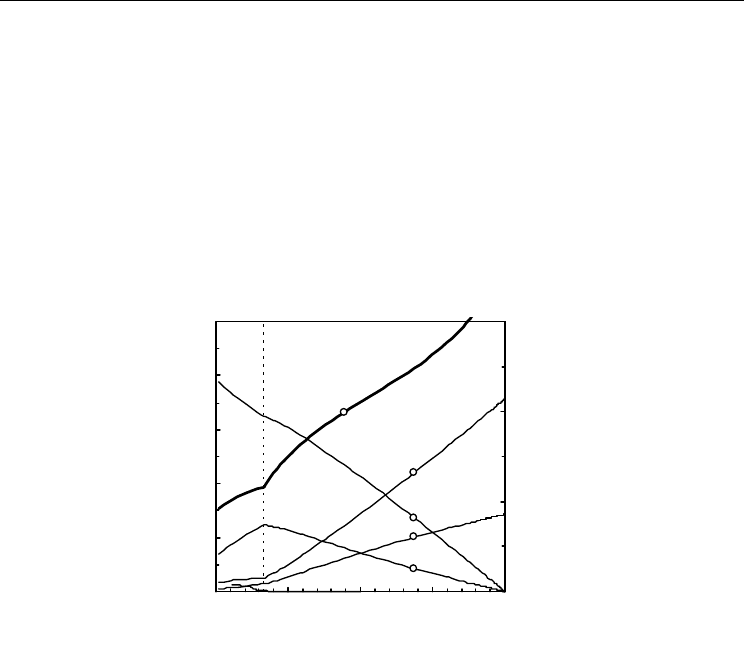
Reducibility of Ceria-Based Materials Exposed to Fuels and under Fuel/Air Gradients
355
al., 2004). A revision of this procedure has also been performed to account for conditions
when carbon depositions are likely to occur. This extension combines the previous reactions
with the equilibrium constant for methane cracking:
42
CH C(s)+2H⇔ (37)
and additional conditions for conservation of every elemental species (C, H and O). A
representative example is shown in Fig. 19, for initial H
2
O:CH
4
=0.5:1 ratio, at 750ºC. A
vertical dashed line shows the lowest level of oxidation oxygen:methane ratio required to
ensure thermodynamic inhibition of carbon deposition. Note that this transition is also
revealed by discontinuities in dependence of gas fractions on O
2
:CH
4
ratio. Higher
steam:metane ratio is, thus, needed to minimise risks of carbon deposition.
CO
CO
2
H
2
H
2
O
pO
2
0
0.2
0.4
0.6
0.8
1
00.511.52
O
2
:CH
4
gas composition
-24
-22
-20
-18
log(pO
2
/atm)
Carbon deposition
750 ºC
(H
2
O:CH
4
)
0
=0.5
Fig. 19. Equilibrium gas composition (left vertical axis) and oxygen partial pressure (right
vertical axis) at 750ºC as a function of oxygen:fuel ratio and with steam:methane ratio 0.5.
The dependence of the gas species on the oxygen partial pressure can be combined with the
electronic properties of materials to obtain the electronic transport number as function of the
fully oxidised species (CO
2
and H
2
O). One example is shown in Fig. 20 for a Ce
0.8
Gd
0.2
O
1.9-
Δδ
sample at 750 ºC, with starting value H
2
O:CH
4
= 1 and with several imposed values of
anodic overpotentials. The increase in the content of fully oxidised species, and increasing
anodic polarisation produces decrease of the electronic transport, thus lowering the impact
of very reducing atmospheres. The analysis could be also performed paying attention to the
effect produced by gradual oxidation on the cell voltage of the mixed conducting
membrane. Figure 21 shows an example of the open cell voltage for Ce
1-x
Sm
x
O
2-0.5x-
Δδ
(x= 0.1,
0.2, 0.3) as a function of the contents of fully oxidised species. The increase of the
concentration of these species reduces the open cell voltage, as expected for the decrease in
oxygen chemical potential difference, with a moderate difference relative to the behaviour
expected for a pure ionic conductor (Nernst potential). Yet, the contribution of this
difference decreases gradually with increasing fuel oxidation, due to corresponding
decrease in electronic conductivity. As a final consideration the values of open cell voltage
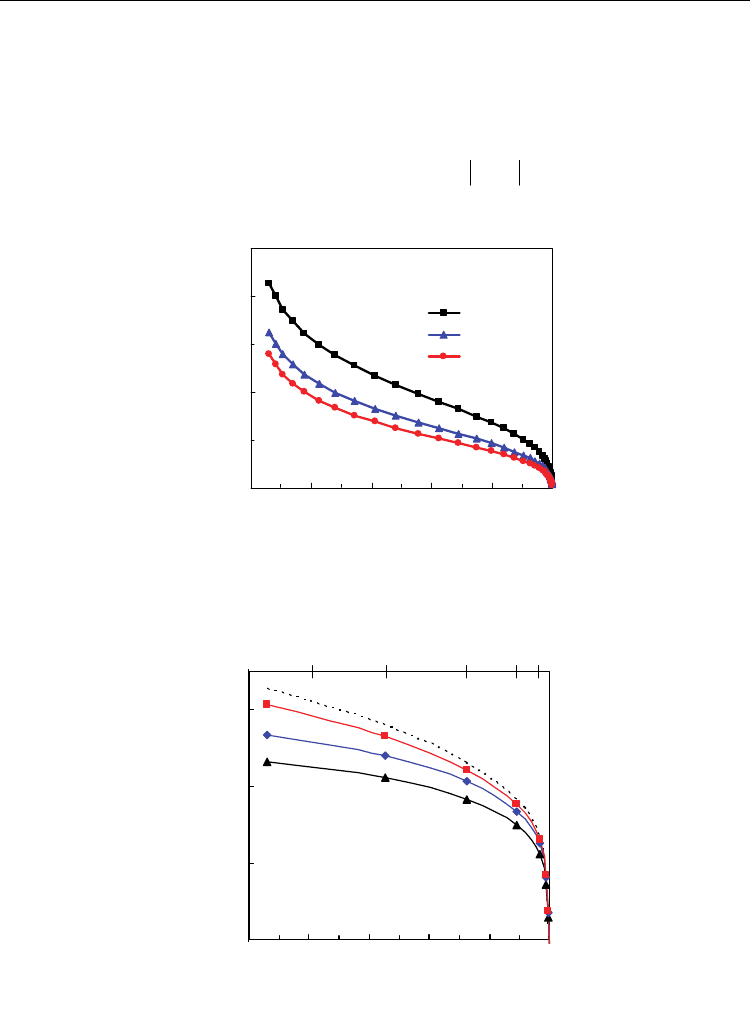
Advances in Ceramics - Synthesis and Characterization, Processing and Specific Applications
356
presented in this chapter may still deviate from the ideal behaviour for a solid electrolyte
with residual electronic conductivity, due to the residual anodic polarisation caused by the
internal current leakage (Frade et al., 2006 and 2008). As consequence the predictions for
open cell voltage may still be somewhat overestimated, and the actual corrected solution
should include these overpotential terms related to internal leakage:
mc o e,av a,leak c,leak
OVC = OCV (1-t )+η + η (38)
where
η
a,leak
and η
c,leak
are the anodic and cathodic overpotential contributions.
0
0.2
0.4
0 0.2 0.4 0.6 0.8 1
pCO
2
+pH
2
O (atm)
t
e
0 mV
50 mV
75 mV
750 ºC
H
2
O:CH
4
= 1
Ce
0.8
Gd
0.2
O
1.9
−Δδ
η
a
= 50 mV
η
a
= 0 mV
η
a
= 75 mV
Fig. 20. Electronic transport number of Ce
0.8
Gd
0.2
O
1.9-
Δδ
at 750 ºC vs. fraction of fully oxidised
species (CO
2
and H
2
O) for η
h
= 0, 50 and 75 mV, with initial H
2
O:CH
4
= 1:1.
x= 0.1
x=0.2
x=0.3
10
-22
10
-20
10
-21
10
-19
10
-18
pO
2
/atm
0.7
0.8
0.9
1
0 0.2 0.4 0.6 0.8 1
(pCO
2
+pH
2
O) / atm
OCV (V)
T=700 ºC
H
2
O:CH
4
=1.25
Pure ionic
conductor
Fig. 21. Open cell voltage at 700 ºC as function of the content of pO
2
+pH
2
for Ce
1-x
Sm
x
O
2-0.5x-
Δδ
system (x= 0.1, 0.2, 0.3) and for a starting steam:methane ratio 1.25.
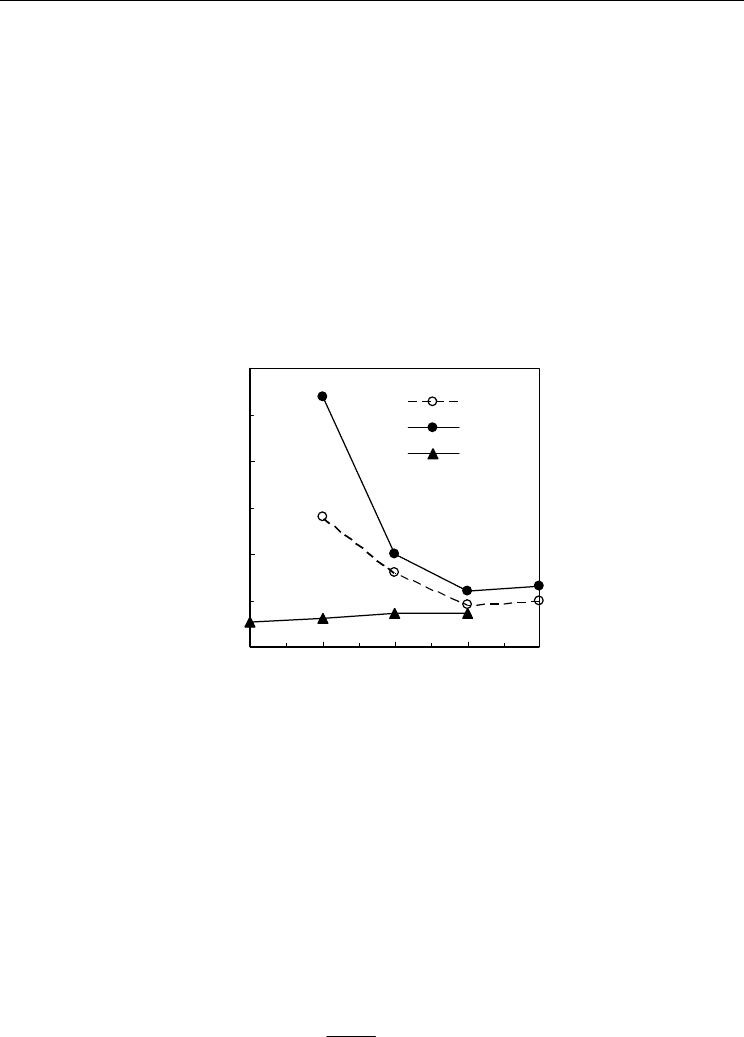
Reducibility of Ceria-Based Materials Exposed to Fuels and under Fuel/Air Gradients
357
5. Constraints imposed by chemical expansion
Reduction from Ce
4+
to Ce
3+
also causes lattice expansion, and risks of significant stresses
under high gradients of chemical potential (Atkinson & Ramos, 2000). Chemical expansion
is usually correlated to oxygen stoichiometry changes relative to air (reference conditions),
and described by the chemical expansion coefficient
ε’
C
= Δε/Δδ. Representative results are
shown in Fig. 22. One can see that cerias often show quite higher chemical expansion
coefficient than typical perovskite mixed conductors such as LSCF (Lein et al, 2006). On
combining the chemical expansion coefficient with the dependence of oxygen stoichiometry
on oxygen:fuel ratio, and overpotential one obtained the results shown in Fig. 23. For very
low fuel conversion and low anodic polarisation this yields a strain contribution in the order
of 0.6%. Indeed, chemical strain may also contribute to the enhanced redox tolerance of Ni-
CGO cermet anodes (Ouweltjes et al, 2009), as chemical contraction of CGO may provide
compensation for expansion caused by partial oxidation of Ni to NiO.
0.0
0.1
0.2
0.3
600 700 800 900 1000
T (ºC)
Δε
C
/
Δδ
CGO10
CGO20
LSCF
Fig. 22. Representative results of chemical expansion coefficient of Ce
0.9
Gd
0.1
O
2
−δ
(CGO10),
Ce
0.8
Gd
0.2
O
2
−δ
(CGO20) (Atkinson & Ramos, 2000), and La
0.5
Sr
0.5
Fe
0.5
Co
0.5
O
3
−δ
(LSCF) (Lein et
al, 2006).
In order to assess the impact of chemical expansion on thermochemical stresses one may
combine chemical strain
ε
C
(x) superimposed on a stress related contribution, in flat
constrained conditions as follows:
C
= (x)(1- )/E + (x)
γ
εσ ν ε (39)
where
σ (x) denotes stress, E is Young modulus and ν is the Poisson ratio.
For flat constrained conditions, the resulting strain
ε
γ
remains uniform across the membrane,
and thus:
C
E
(x) (x)
(1 )
γ
σ= ε−ε
−ν
(40)
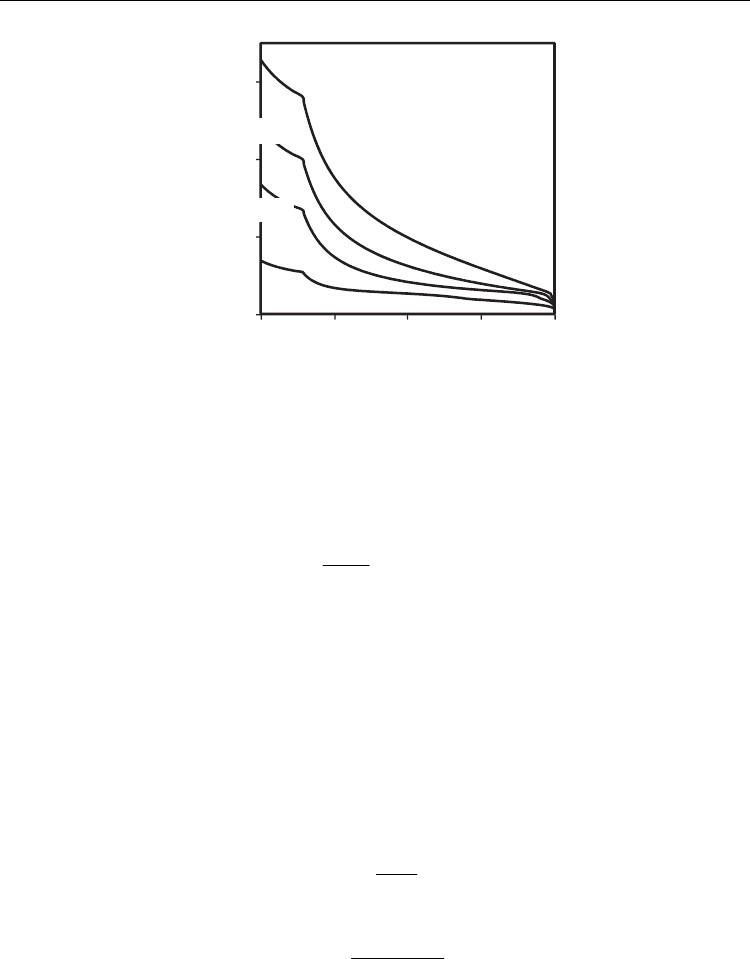
Advances in Ceramics - Synthesis and Characterization, Processing and Specific Applications
358
η=0
0.05V
0.2V
0.1V
0
0.2
0.4
0.6
00.511.52
ε
c
(%)
O
2
:CH
4
(H
2
O:CH
4
)
0
=0.5
1073 K
Fig. 23. Chemical expansion of CGO20 vs O
2
:CH
4
ratio for (H
2
O:CH
4
)
0
=0.5, at 800ºC, and for
anodic polarisation
η=0, 0.05, 0.1, 0.2 V.
This can be combined with the additional condition for externally unconstrained
membranes:
''
2
'
2
O
L
2
2
0
O
L
dx d O 0
O
μ
μ
σ≈ σ
μ
=
Δμ
(41)
where L is the thickness of membrane, and d
μO
2
=RTdln(pO
2
) is the elemental change in
chemical potential. For linear dependence of chemical potential across the membrane, and
on combining Eqs. 40 and 41 one obtains:
()
2
2
pO
1
22 C 2
pO
lo
g
pO /pO dlo
g
(pO )
′′
−
γ
′
′′ ′
ε= ε
(42)
If x represents distance from air, and this is taken as reference, i.e. ε
c
(0)=0, the stresses at
surfaces in contact with air x=0 and contact with fuel (x=L) become:
()
()
γ
E·ε
σ 0=
1-ν
(43)
()
()
()
γ C
E ε -ε (L)
σ L=
1-ν
(44)
Dependence on oxygen partial pressure is then easily transformed to the corresponding
conversion of fuels, based on the previous thermodynamic analysis for hydrogen or
methane-based fuels.
